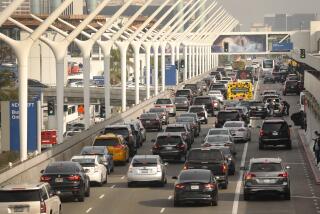LAX had a nightmarish holiday season of delays and gridlock. It’s likely a preview of the airport’s growing pains
- Share via
It was Christmastime at Los Angeles International Airport. Security lines were long, passengers crowded the terminals and restaurants ran short of food. Airlines delayed and canceled several hundred departures and arrivals because of bad weather.
At the gates, travelers booed and cheered announcements about flight schedules, depending on the news. Some people slept on the floor. Outside, traffic was so heavy it often took an hour or more to drive the two miles between the 405 Freeway and the terminals.
“I’ve been flying in and out of LAX since the ’80s and it was the most chaotic experience I’ve ever had,” said Frank Girardot of Pasadena, whose flight to Detroit the night of Dec. 22 was delayed about four hours.
The 19-day holiday season for LAX and its unprecedented surge in travelers will end Tuesday. But the experience of several million passengers passing through its gates might be an indicator of what lies ahead if the nation’s third-busiest airport continues to expand at a record pace.
Airport consultants and commercial aviation experts say traffic and terminal congestion will probably persist, especially during peak travel times of the year, because of a variety of factors, including an ongoing modernization of the facility that has yet to catch up with its dramatic growth since the recession.
An estimated 80 million passengers will travel through LAX this year — an increase of about 8% over 2015 and about 30% since 2010. The Southern California Assn. of Governments, a regional planning agency, predicts that LAX will handle 96.6 million passengers annually by 2040.
During this year’s holiday period alone, LAX had an estimated 4.3 million travelers, about 400,000 more than in 2015.
The airport was built to handle 40 million passengers annually for the ’84 Olympics. Last year, there were 75 million...
— Jack Keady, an airport and aviation consultant
“It’s a straight mathematical equation,” said Jack Keady, an airport and aviation consultant based in Playa del Rey. “The airport was built to handle 40 million passengers annually for the ’84 Olympics. Last year, there were 75 million and projections call for almost 100 million. The congestion is only going to get worse.”
Airport officials said they are concerned about congestion and that Los Angeles World Airports, the operator of LAX, is taking major steps to improve ground transportation and the efficiency of airfield operations.
“The holiday crush is something we are used to — Thanksgiving, summer and the Christmas rush,” said Bob Gilbert, chief development officer for the airport. “But as we move forward, congestion is going to be exacerbated if we don’t take appropriate action to address the issues that will challenge our facilities.”
As with other major airports, Gilbert said much of the holiday congestion at LAX has resulted from bad weather in L.A. and other parts of the country that caused flight delays and cancellations. “The places where people fly in from have issues of their own,” he added. “This affects LAX.”
During the holiday peak — Dec. 21-23 — about 239,000 travelers passed through the airport each day. Baggage-claim areas were packed, and long lines formed on the street to check luggage curbside.
The airlines had added so many flights to handle increased demand that the Federal Aviation Administration ordered a slowdown in operations on Monday to help clear arriving aircraft from taxiways where they were backed up because of a shortage of gates.
“There were tons of people. We couldn’t get any information anywhere,” said Rodney Leong of San Francisco, whose departing flight on Dec. 21 was delayed 4½ hours. “Do the words ‘fall of Saigon’ mean anything to you? I wouldn’t recommend flying into LAX unless you have to.”
Airport officials said that from Dec. 22 to Dec. 29, 2,101 arrivals and departures were delayed and 161 arrivals and departures were canceled.
Even before the holiday crush, passenger growth combined with airport construction was snarling traffic in the terminal area and on main access routes including the 105 Freeway and Sepulveda, La Tijera and Century boulevards.
Over the years, daily traffic has steadily increased from 70,000 vehicles in the central terminal area to more than 95,000 today. The week before Christmas, the vehicle flow peaked at 108,000 on Dec. 21.
At the busiest times, the westbound 105 turns into a freeway of angst and squeaking brakes as traffic backs up all the way from the Sepulveda offramp to the 405 connector.
“They are trying to fix an airport at the same time it is operating and increasing capacity,” said Denny Schneider, president of the Alliance for a Regional Solution to Airport Congestion. “The traffic we are now seeing is the new normal.”
LAX officials say that airline passengers will get a break for a few months after the holidays when travel significantly declines. However, congestion is expected to resume in the summer, when passenger volumes usually reach their highest levels for the year. In July, LAX handled about 7.9 million travelers.
Los Angeles World Airports expects to cut traffic congestion in and around the airport with a new Metro light-rail connection, an automated people mover in the terminal area and two transportation centers east of the airport, though these upgrades are years away.
Plans call for the construction of new roads and the improvement of local streets to serve the transportation centers and a consolidated car rental facility to be built in Manchester Square. Sepulveda, Aviation and West Century boulevards, 98th Street and West Arbor Vitae are some of the major thoroughfares to be upgraded.
Airport officials believe they can remove 40% of the terminal-area traffic by requiring buses, shuttles and courtesy vans to drop off and pick up passengers at the transportation centers that will be linked to the people mover.
On the airfield, taxiways and runways have been or will be improved. Also planned is a midfield concourse with 11 new gates, terminal space and taxiways.
The work is part of a multibillion-dollar effort to remake and expand the airport’s transportation system, runways, taxiways, utilities and passenger terminals, including its centerpiece, the Tom Bradley International Terminal.
“Our development and improvements are right in parallel with where we are,” said Gilbert, who oversees airport development. “As we do our development, it will arrive just in time to accommodate the growth.”
When he got to LAX on Dec. 22, Ali Rizvi, who lives in the San Gabriel Valley, said he expected some improvement because of the new construction. But it took four hours to pick up his daughter because of traffic congestion, the time her flight spent on the tarmac waiting for a gate, and a delay in baggage claim.
“It just seems like it’s been getting worse,” Rizvi said.
Twitter: @LADeadline16
Twitter: @adamelmahrek
ALSO
Two injured when helicopter crashes on Mt. Baldy
California’s top court says public may see government’s legal bills
L.A.’s wettest month in years will continue through to New Year’s Eve
UPDATES:
4:10 p.m.: This article was updated to say that several transit upgrades around the airport are years away.
This article was originally posted at 3:05 p.m.
More to Read
Sign up for Essential California
The most important California stories and recommendations in your inbox every morning.
You may occasionally receive promotional content from the Los Angeles Times.












